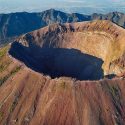The eruptive activity that has repeatedly wiped out the vegetation, the fortunate geographical position, the mild climate and the profound anthropic changes are the basis of the coexistence, in a relatively small territory, of many different environmental types and in various stages of evolution: from the expanses of lava to the vast broom thickets, from holm oaks to pine forests planted in the second half of the last century and mixed forests on the Somma side. The slopes are instead home to wide agroecosystems that are part of an agricultural landscape progressively more fragmented proceeding towards the coast, lastly affected by a pervasive and disordered urban fabric.
Vesuvius is characterized by an irregular morphology and without an established surface hydrographic network, and by a relatively warm and dry Mediterranean climate. The biological component is characterized by pioneer ecosystems that colonize the deposits of ash and lava flows, from the expanses of Stereocaulon vesuvianum, to the extensive Mediterranean shrubs and associations mainly of holm
oak, up to the pine forests that were planted in the second half of the last century.
The volcanic complex can be divided into two considerably different “subsystems”: the southern part of the volcanic apparatus – Vesuvius – has a young morphology and has been repeatedly upset over the last two millennia by the succession of eruptive activity; the oldest part, consisting of the northern slopes of Mount Somma, retains the mature morphology prior to the Plinian eruption of 79 AD.

The northern slope of Mount Somma represents the quiet facies of the volcano, characterized by extensive broadleaf and chestnut forests and, in some areas, by ancient terraces that go up the slopes to the edge of the forest, thus creating space to host orchards and characteristic vegetable gardens. The mixed woods have associations of downy oak (Quercus pubescens), black hornbeam (Ostrya carpinifolia), manna ash (Fraxinus ornus), Neapolitan alder (Alnus cordata), maple (Acer spp.), small groups of birch (Betula pendula), poplars (Populus spp.) and willows (Salix spp.).












